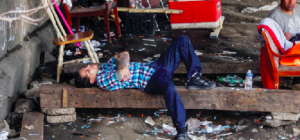Noble Brigham ‘20:
The past few years have seen a rise in the opioid epidemic – now one of the largest social problems in the United States. In January 2018, Governor Wolf declared a 90-day state of emergency. According to the CDC, from 2014-2015, drug-related deaths in Pennsylvania, mostly from opioids, increased by 20.1%, and from 2015-2016, they increased by 44.1%. In 2016, there were 2,089 heroin-related deaths in Pennsylvania.
Kensington, Philadelphia is the center of the opioids epidemic in the Philadelphia region. It is home to the Conrail rail yard where addicts slept in cardboard and plywood shacks in the midst of trash piles and dirty needles. The infamous Conrail yard was then cleaned and sealed, which caused the addicts to move to other places. Now there is a needle exchange, run by an organization called Prevention Point Philadelphia, where addicts can swap dirty needles for clean ones.
An injection site in Kensington is currently being planned that will allow addicts and users to use heroin without being on the street and under the supervision of staff and emergency medical services. The site will not be run by the city, but was authorized by city officials. Now experiential programs like injection sites are becoming increasingly popular across the US and Canada, drawing both criticism and support. Some think the injection sites encourage and attract drug users to locate there. Others believe they offer addicts a safe space to consume drugs, with clean needles and the anti overdose drug Narcan easily available.
Joe Shanahan, Head of Security at EA, is not sure about the helpfulness of these injection sites and said, “I worry about first of all where they’re going to be…as opposed to enabling or encouraging its use I’d like to see more treatment centers to combat it, alternatives to hardcore pain killers.” Kevin Sporici ‘20 echoed this thought, saying that “In the end you’re encouraging the use because you’re not finding a long-term solution, it’s a quick fix. There is no way to truly stop the drug problems because people are always going to use.”
Kensington is home to a major exploitation of drug users, amounting to human trafficking: “pimping out addicts,” when a recovery house is paid cash to take addicts to certain treatment centers. The operators of the center then pay the operators of the recovery house to get patients. The treatment center operators are paid by the government, and the recovery house operators are paid by the treatment center. This is illegal, because it is the addicts’ choice as to which treatment center they go. The recovery houses in Kensington operate out of row houses, converted and crammed with as many beds as possible.
Anyone can run one, including a woman who claims to have been a prostitute, and a “pastor” who was convicted of torching his car for insurance money. The houses cannot be regulated unless they take government money and because of treatment center kickbacks, many do not need to do so.
Another form of exploitation of the opioid epidemic is the Air Bridge program. Puerto Rico has sent addicts to Philadelphia for years, dumping their problem on the city. They tell the addicts they will go to a paradise where they will be able to recover, and instead the addicts are taken to illegitimate recovery houses. They are forced to apply for welfare which the recovery house operators pocket, and they give all identification to the operators who use it as leverage to keep the person there. Puerto Rico cleans up their cities, and Philadelphia gets more heroin addicts.

Solutions are difficult, because patients often fall into a rehabilitation relapse. When asked why this happens, Anne Ravreby, EA School Nurse, explained the impact of the drug on the user: “The way they work is they hit your receptors in your spine… they make you feel better so you don’t feel the pain and then what happens is it takes more and more to get that same level of relief.”
Ravreby also made the point that “people’s perception of pain varies,” in other words, some people will feel they need more medication than others. Ravreby said, “It started over with the prescription of opioids for pain and then people became addicted to them. It’s also the use of fentanyl which is synthetic…opioids are grown…so it became a street drug and then after that it got too expensive so everybody switched over to heroin.” Shanahan echoed this, saying, “I think the medical community has a lot to do with it.” Often, prescriptions for opioids are prescribed after medical treatment, and then the recipients cannot get off of them – becoming avid users.
Though there is such a big problem so close by, Episcopal is only helping indirectly. Rebecca Brinks, Director of Community Service and Outreach, said that EA works with organizations like UCHC and Broad Street Ministry that are serving some opioid addicts, but is not working with organizations designed to serve addicts. Brinks said, “I would be open to doing work in Kensington,” but “for students, we always have to consider safety….I feel like things like feeding programs, schools are more appropriate learning experiences for students.” She said there is a church that has a “feeding program” but “they have so many people that volunteer there that they have slots filled for months and months in advance.”
Philadelphia also needs to find a way to get more rehabilitation beds in legitimate facilities. Currently, there are not enough beds to house all the addicts in. While large and widespread, the opioid epidemic in Philadelphia can be improved through hard work, dedication and volunteer from Philadelphians. .